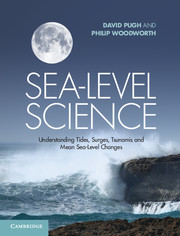Book contents
- Frontmatter
- Contents
- Preface
- List of acronyms
- List of main symbols
- Chapter 1 Introduction
- Chapter 2 Sea-level measuring systems
- Chapter 3 Tidal forces
- Chapter 4 Tidal analysis and prediction
- Chapter 5 Tidal dynamics
- Chapter 6 Shallow-water and coastal tides
- Chapter 7 Storm surges, meteotsunamis and other meteorological effects on sea level
- Chapter 8 Tsunamis
- Chapter 9 Spatial variations in sea level
- Chapter 10 Mean sea-level changes in time
- Chapter 11 Sea-level changes in time to do with the solid Earth
- Chapter 12 Sea-level applications
- Chapter 13 Sea level and life
- Appendix A Basic hydrostatic and hydrodynamic equations
- Appendix B Currents
- Appendix C High and low water times and heights from harmonic constituents
- Appendix D Theoretical tidal dynamics
- Appendix E Legal definitions in the coastal zone
- Glossary
- Index
- References
Appendix E - Legal definitions in the coastal zone
Published online by Cambridge University Press: 05 May 2014
- Frontmatter
- Contents
- Preface
- List of acronyms
- List of main symbols
- Chapter 1 Introduction
- Chapter 2 Sea-level measuring systems
- Chapter 3 Tidal forces
- Chapter 4 Tidal analysis and prediction
- Chapter 5 Tidal dynamics
- Chapter 6 Shallow-water and coastal tides
- Chapter 7 Storm surges, meteotsunamis and other meteorological effects on sea level
- Chapter 8 Tsunamis
- Chapter 9 Spatial variations in sea level
- Chapter 10 Mean sea-level changes in time
- Chapter 11 Sea-level changes in time to do with the solid Earth
- Chapter 12 Sea-level applications
- Chapter 13 Sea level and life
- Appendix A Basic hydrostatic and hydrodynamic equations
- Appendix B Currents
- Appendix C High and low water times and heights from harmonic constituents
- Appendix D Theoretical tidal dynamics
- Appendix E Legal definitions in the coastal zone
- Glossary
- Index
- References
Summary
In Chapters 2 and 9 we looked at different tidal levels and their use as zero or Datum Levels [1]. Tidal datums are also used to define shorelines, adopted as the state, national and international boundaries shown on maps. Generally the important levels are some form of High Tide, or some form of Low Tide, depending on locally adopted definitions. The determination of these levels, and their projection to mapped shorelines may require long records of sea-level measurements, often a complete nodal cycle of 18.61 years. Inevitably, knowledge of tidal principles has an important role to play in the development and interpretation of legal rules, but the technical aspects of defining tidal boundaries have sometimes been underemphasised [2].
The three components of a robust boundary definition are:
clear and measurable tidal level parameters,
a means of converting these levels into map coordinates,
a legal system for interpreting and enforcing the boundaries.
To these we might add a process for adjusting to tidal and coastal changes over the long-term.
- Type
- Chapter
- Information
- Sea-Level ScienceUnderstanding Tides, Surges, Tsunamis and Mean Sea-Level Changes, pp. 376 - 379Publisher: Cambridge University PressPrint publication year: 2014



